Wikipedia:Picture of the day/August 2006
|
Featured picture tools: |
These featured pictures, as scheduled below, appeared as the picture of the day (POTD) on the English Wikipedia's Main Page in August 2006.
You can add an automatically updating POTD template to your user page using {{Pic of the day}} (version with blurb) or {{POTD}} (version without blurb). For instructions on how to make custom POTD layouts, see Wikipedia:Picture of the day.
August 1 - Tue
[edit]
|
| A panorama of Machu Picchu Sanctuary, showing the prominent peak of Huayna Picchu. Machu Picchu, probably the most familiar symbol of the Inca Empire, is a well-preserved pre-Columbian Inca ruin located above the Urubamba Valley in Peru at about 2,350 m (7,710 ft). Since 1983 the site has been designated as a UNESCO World Heritage Site, and has been the subject of concern about damage caused by tourism.
Photo credit: Rubyk/Fir0002 |
Text version ( view - edit - talk - history ) — Condensed version ( view - edit )
Column version ( view - edit ) — Row version ( view - edit )
August 2 - Wed
[edit]
|
Though technically digital art may be any art created using other media or processes, and then digitally scanned, the term is usually reserved for art that has been non-trivially modified by a computing process. This particular image was created with POV-Ray 3.6 using radiosity. The glasses, ashtray and pitcher were modeled with Rhino and the dice with Cinema 4D. The entire image took 560 hours to render. Photo credit: Gilles Tran/Deadcode |
Text version ( view - edit - talk - history ) — Condensed version ( view - edit )
Column version ( view - edit ) — Row version ( view - edit )
August 3 - Thu
[edit]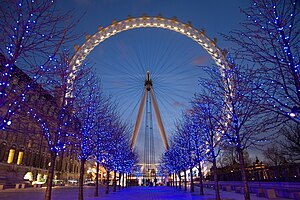
|
Seen here from the rear at twilight, the London Eye, also known as the Millennium Wheel, is the largest observation wheel (a type of Ferris wheel) in the world at 135 m (443 ft) high. The wheel carries 32 sealed passenger capsules and rotates at a rate of 0.26 m/s (about 0.9 km/h or 0.6 mph) so that one revolution takes about 30 minutes to complete. Photo credit: Diliff |
Text version ( view - edit - talk - history ) — Condensed version ( view - edit )
Column version ( view - edit ) — Row version ( view - edit )
August 4 - Fri
[edit]
|
| A panorama of Australia's most substantial mountain range, the Great Dividing Range, which stretches from the northeastern tip of Queensland to the Grampians in western Victoria and divides the watersheds of streams and rivers which flow directly into the Pacific Ocean on the eastern coast of Australia, from those of the Murray-Darling Basin which flow away from the coast into the interior plains.
Photo credit: Fir0002 |
Text version ( view - edit - talk - history ) — Condensed version ( view - edit )
Column version ( view - edit ) — Row version ( view - edit )
August 5 - Sat
[edit]
|
The Rathaus or City Hall of Graz, the second-largest city in Austria after Vienna, at dusk. Graz was the 2003 European Capital of Culture and its "Old Town" is included in the UNESCO list of World Cultural Heritage Sites. Occupying a strategic location, Graz began as Roman fort and survived numerous assaults over the centuries. Photo credit: Tam |
Text version ( view - edit - talk - history ) — Condensed version ( view - edit )
Column version ( view - edit ) — Row version ( view - edit )
August 6 - Sun
[edit]
|
Satellite image of Cyclone Gafilo, a powerful Category 5 tropical cyclone which struck Madagascar in March 2004, causing devastating damage. This was taken just before landfall, when the system was at its peak intensity about 333 km (207 mi) east of Madagascar, with sustained windspeed of 260 km/h (160 mph). At least 250 people were listed dead, with more missing, and 300,000 people were left homeless due to Gafilo. Photo credit: Terra satellite, NASA |
Text version ( view - edit - talk - history ) — Condensed version ( view - edit )
Column version ( view - edit ) — Row version ( view - edit )
August 7 - Mon
[edit]
|
Cutaway rendering of a cathode ray tube (see legend). The CRT was invented by Karl Ferdinand Braun, based on work by Philo Farnsworth, and was the display device that was traditionally used in most computer displays, video monitors, televisions, radar displays and oscilloscopes until the late 20th century before the advent of plasma screens, LCD TVs, DLP, OLED displays, and other technologies. Photo credit: Søren Peo Pedersen/grm_wnr |
Text version ( view - edit - talk - history ) — Condensed version ( view - edit )
Column version ( view - edit ) — Row version ( view - edit )
August 8 - Tue
[edit]
| |
| Panorama of the fortified city of Carcassonne (Aude, France) and the Pont Vieux crossing the Aude River. The fortress of Carcassonne was considered impregnable and never conquered. It was begun by the Romans and built up through the years. It fell into disrepair and was restored in the 19th century. It is now a UNESCO World Heritage Site.
Photo credit: Jean-Pierre Lavoie | |
Text version ( view - edit - talk - history ) — Condensed version ( view - edit )
Column version ( view - edit ) — Row version ( view - edit )
August 9 - Wed
[edit]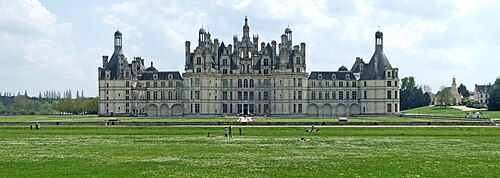
|
| With its very distinct Renaissance architecture, the Château de Chambord in Chambord, Loir-et-Cher, France, is one of the most recognizable châteaux in the world. The massive castle, originally built as a hunting lodge for King François I, features 440 rooms, 365 fireplaces, and 84 staircases. The château was never intended to provide any form of defence from imagined enemies. As such, the walls, towers and partial moat are purely decorative.
Photo credit: Stevage/Yummifruitbat |
Text version ( view - edit - talk - history ) — Condensed version ( view - edit )
Column version ( view - edit ) — Row version ( view - edit )
August 10 - Thu
[edit]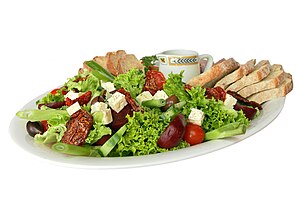
|
A salad platter, consisting of bread, lettuce, spring onions, cucumber, feta cheese, sun-dried tomatoes, beetroot, cherry tomatoes, olives, and dressing. "Salad" is actually a broad term applied to many food preparations that are a mixture of chopped or sliced ingredients. A salad can be served cold or at room temperature, though it also can form the filling for a hot sandwich. While it can be made with meat or eggs, it usually includes at least one raw vegetable or fruit. Photo credit: Fir0002 |
Text version ( view - edit - talk - history ) — Condensed version ( view - edit )
Column version ( view - edit ) — Row version ( view - edit )
August 11 - Fri
[edit]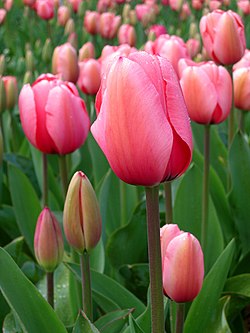
|
There about 100 species of tulip, native to southern Europe, north Africa, and Asia. They are perennial bulbous plants growing to 10-70 cm tall with large flowers with six tepals. Besides being the national flower of Iran and Turkey, tulips are closely associated with the Netherlands, so much so that the term "Dutch tulips" is often used for the cultivated forms. Photo credit: John O'Neill |
Text version ( view - edit - talk - history ) — Condensed version ( view - edit )
Column version ( view - edit ) — Row version ( view - edit )
August 12 - Sat
[edit]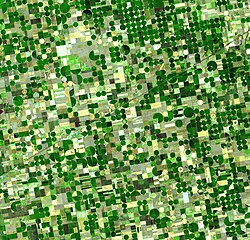
|
Satellite image of circular crop fields, characteristic of center pivot irrigation, in Haskell County, Kansas in late June 2001. Healthy, growing crops are green. Corn would be growing into leafy stalks by then. Sorghum, which resembles corn, grows more slowly and would be much smaller and therefore, possibly paler. Wheat is a brilliant gold as harvest occurs in June. Fields of brown have been recently harvested and plowed under or lie fallow for the year. U.S. Route 56 crosses the scene, passing the cities of Sublette (lower left) and Copeland (upper right). Image credit: ASTER (NASA) |
Text version ( view - edit - talk - history ) — Condensed version ( view - edit )
Column version ( view - edit ) — Row version ( view - edit )
August 13 - Sun
[edit]
|
This photo of the Nilov Monastery on Stolbnyi Island in Tver Oblast, Russia, was taken by Sergei Mikhailovich Prokudin-Gorskii in 1910 before the advent of colour photography. His process used a camera that took a series of monochrome pictures in rapid sequence, each through a different coloured filter. By projecting all three monochrome pictures using correctly-coloured light, it was possible to reconstruct the original colour scene. Photo credit: Sergei Mikhailovich Prokudin-Gorskii |
Text version ( view - edit - talk - history ) — Condensed version ( view - edit )
Column version ( view - edit ) — Row version ( view - edit )
August 14 - Mon
[edit]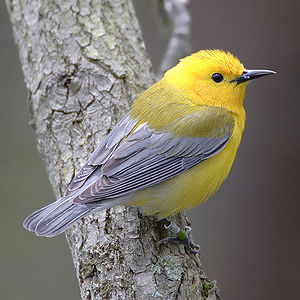
|
The Prothonotary Warbler is a small songbird of the New World warbler family. It breeds in hardwood swamps in southern Canada and the eastern United States, nesting in a cavity. The male often builds several incomplete unused nests in his territory; the female builds the real nest. It winters in the West Indies, Central America and northern South America. This bird was named after officials in the Roman Catholic Church known as the protonotarii, who wore golden robes. Photo credit: Mdf/Fir0002 |
Text version ( view - edit - talk - history ) — Condensed version ( view - edit )
Column version ( view - edit ) — Row version ( view - edit )
August 15 - Tue
[edit]
|
The second-most populous nation in the world, India has long played a major role in human history. Hinduism, Sikhism, Buddhism and Jainism all have their origins in India, while Islam and Christianity enjoy a strong cultural heritage. Colonised as part of the British Empire in the nineteenth century, India gained independence in 1947 as a unified nation after an intense struggle for independence. This blank map of India is one of the most comprehensive on the Internet in terms of its borders with respect to its territorial disputes with Pakistan and China. Map credit: Nichalp |
Text version ( view - edit - talk - history ) — Condensed version ( view - edit )
Column version ( view - edit ) — Row version ( view - edit )
August 16 - Wed
[edit]
|
Mont Saint Michel, a small rocky tidal island in Normandy, is famous for its Benedictine abbey (spire pictured here) and steepled church (built between the 11th and 16th centuries) which occupy most of the island. The abbey was constructed in the 11th century, but by the time of the French Revolution its popularity had waned to the point where there were scarcely any monks in residence and it was converted to a prison. However, in 1874 it was declared a national monument and is on the list of UNESCO World Heritage Sites. Photo credit: Nilington |
Text version ( view - edit - talk - history ) — Condensed version ( view - edit )
Column version ( view - edit ) — Row version ( view - edit )
August 17 - Thu
[edit]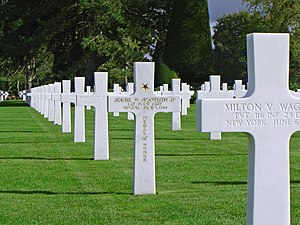
|
Located on a cliff overlooking Omaha Beach, the World War II Normandy American Cemetery and Memorial in Colleville-sur-Mer, Normandy, France honors American soldiers who died in Europe during World War II. Shown here is the grave marker of Jimmie W. Monteith, a United States Army officer who was posthumously awarded the Medal of Honor for his heroic actions and sacrifice of life on D-Day. Photo credit: Nilington |
Text version ( view - edit - talk - history ) — Condensed version ( view - edit )
Column version ( view - edit ) — Row version ( view - edit )
August 18 - Fri
[edit]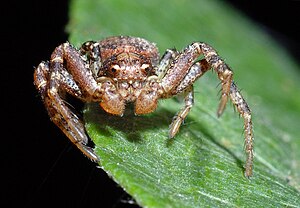
|
The Ozyptila praticola species of crab spider is found throughout Europe and the Middle East. They do not build webs to trap prey, but are active hunters. Crab spiders are so named because of their first two pairs of legs, which are held out to the side giving them a crab-like appearance. Also, like crabs, these spiders move sideways and backwards more easily than forwards. Photo credit: André Karwath |
Text version ( view - edit - talk - history ) — Condensed version ( view - edit )
Column version ( view - edit ) — Row version ( view - edit )
August 19 - Sat
[edit]
|
The white-lipped snail (Cepaea hortensis) is a very close relative of the grove snail. It is very slightly smaller than the grove snail, but shares the same variation in shell colour and banding. The principal distinguishing feature is a white band at the lip of the shell, although this is not reliable for accurate identification. The two species can mate and reproduce. The two species share the same habitats, although the range of the white-lipped snail extends closer to the Arctic in Northern Europe. Photo credit: Every1blowz/Fir0002 |
Text version ( view - edit - talk - history ) — Condensed version ( view - edit )
Column version ( view - edit ) — Row version ( view - edit )
August 20 - Sun
[edit]
|
A specimen from the "hybrid zone" of the Leaf Green Tree Frog (Litoria phyllochroa) and the Southern Leaf Green Tree Frog (L. nudidigitus), showing physical characteristics of both species. These small stream-dwelling frogs (averaging only 40mm in length), are native to eastern Australia and occur together south of Sydney. The two species are differentiated only by distribution, call and slight differences in flank markings. Photo credit: Froggydarb |
Text version ( view - edit - talk - history ) — Condensed version ( view - edit )
Column version ( view - edit ) — Row version ( view - edit )
August 21 - Mon
[edit]
|
| Lower Manhattan (seen here from the Staten Island Ferry) is the southernmost part of the island of Manhattan, the main island and center of business and government of the City of New York. Lower Manhattan includes City Hall, the Municipal Building, the Financial District and the site of the World Trade Center. This area is also the earliest settled (by Europeans) area, and is one of the few areas of Manhattan that does not have its streets arranged in a strict grid pattern.
Photo credit: Diliff |
Text version ( view - edit - talk - history ) — Condensed version ( view - edit )
Column version ( view - edit ) — Row version ( view - edit )
August 22 - Tue
[edit]
The 1906 San Francisco earthquake struck at 5:12am on Wednesday, April 18 1906 with a moment magnitude (Mw) of 7.8. The mainshock epicenter occurred offshore about 2 miles from the city along the San Andreas Fault. The earthquake and resulting fire would be remembered as one of the worst natural disasters in the history of the United States. This panorama of the city was taken in May 1906 by the Lawrence Captive Airship, 2000 feet (606 m) above San Francisco Bay overlooking the waterfront with sunset over the Golden Gate. Photo credit: George R. Lawrence Co. |
Text version ( view - edit - talk - history ) — Condensed version ( view - edit )
Column version ( view - edit ) — Row version ( view - edit )
August 23 - Wed
[edit]
|
Old Saint Paul's in Wellington, New Zealand, is an example of 19th-century Gothic Revival architecture adapted to colonial conditions and materials. It is constructed entirely from New Zealand native timbers. While no longer a parish church, it remains consecrated, and is a popular venue for weddings, funerals and other services. This photo of the nave is an example of high dynamic range imaging. Photo credit: Dean S. Pemberton |
Text version ( view - edit - talk - history ) — Condensed version ( view - edit )
Column version ( view - edit ) — Row version ( view - edit )
August 24 - Thu
[edit]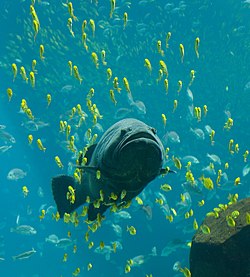
|
The giant grouper (Epinephelus lanceolatus), shown here with a school of golden trevally, is the largest bony fish found in coral reefs, and the aquatic emblem of Queensland, Australia. The species can grow as large as 2.7 meters (9 ft) long, weighing up to 400 kg (880 lb). They are fairly common in shallow waters and feed on a variety of marine life, including small sharks and juvenile sea turtles. Photo credit: Diliff |
Text version ( view - edit - talk - history ) — Condensed version ( view - edit )
Column version ( view - edit ) — Row version ( view - edit )
August 25 - Fri
[edit]
|
This 1927 photo of the Flinders Street Station, the central railway station of the suburban rail network of Melbourne, Australia, shows a mix of motor vehicles and horse drawn carts on the streets, as well as both electric and non-electric trams. The station opened in 1910, replacing an ad hoc collection of weatherboard train sheds. Photo credit: Victoria State Transport Authority |
Text version ( view - edit - talk - history ) — Condensed version ( view - edit )
Column version ( view - edit ) — Row version ( view - edit )
August 26 - Sat
[edit]
|
The hand paintings seen here at the Cueva de las Manos in Santa Cruz Province, Argentina were created between 13,000 and 9,300 years ago using bone-made pipes for spraying the paint on the wall. Most of the hands are left hands, which suggests that painters held the spraying pipe with their dexterous hand. The cave is listed as a UNESCO World Heritage Site. Photo credit: Mariano |
Text version ( view - edit - talk - history ) — Condensed version ( view - edit )
Column version ( view - edit ) — Row version ( view - edit )
August 27 - Sun
[edit]
|
The Greylag Goose (Anser anser) is the ancestor of domesticated geese in Europe and North America. This species is one of the last to migrate and it is thought that the English name signifies late, meaning that they lagged behind the other geese when they left for their northern breeding quarters. Photo credit: Diliff |
Text version ( view - edit - talk - history ) — Condensed version ( view - edit )
Column version ( view - edit ) — Row version ( view - edit )
August 28 - Mon
[edit]
|
Crowds surrounding the Reflecting Pool, during the August 28 1963 March on Washington for Jobs and Freedom. An estimated 200,000 to 500,000 people participated in the march, which featured Martin Luther King Jr.'s famous "I Have a Dream" speech. It was a major factor leading to the passage of the Civil Rights Act of 1964 and the 1965 Voting Rights Act. The march was also condemned by the Nation of Islam and Malcolm X, who termed it the "farce on Washington". Photo credit: Warren K. Leffler/Moondigger |
Text version ( view - edit - talk - history ) — Condensed version ( view - edit )
Column version ( view - edit ) — Row version ( view - edit )
August 29 - Tue
[edit]
|
Red sandstone interior of Lower Antelope Canyon, Arizona, worn smooth due to erosion by flash flooding and wind over millions of years. Antelope Canyon is one of the best-known and most-photographed slot canyons in the world. The flash floods that created the canyon are a danger to tourists. Rain does not have to fall on or near the area for flash floods to whip through, as rain falling dozens of miles away 'upstream' of the canyons can funnel into them with little prior notice. On 12 August 1997, eleven tourists in Lower Antelope Canyon were killed by a flash flood. Very little rain fell at the site that day. Photo credit: moondigger |
Text version ( view - edit - talk - history ) — Condensed version ( view - edit )
Column version ( view - edit ) — Row version ( view - edit )
August 30 - Wed
[edit]
|
This diagram in SVG format shows the terminology for the basic fielding positions in the game of cricket, for a right-handed batsman. The area to a right-handed batsman's left is called the leg side or on side, while the off side is to his right. If the batsman is left-handed, the leg and off sides are reversed and the fielding positions are a mirror image of those shown. The 9 mobile fielders (not counting the bowler and wicket-keeper), are allocated to fielding positions, a crucial strategic decision made by the team captain. Image credit: Miljoshi/Stevage |
Text version ( view - edit - talk - history ) — Condensed version ( view - edit )
Column version ( view - edit ) — Row version ( view - edit )
August 31 - Thu
[edit]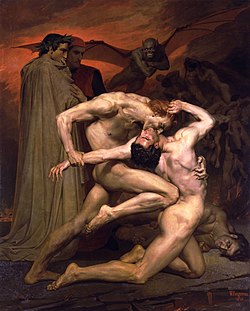
|
Dante and Virgil in Hell (1850), inspired by Dante Alighieri's The Divine Comedy, was William-Adolphe Bouguereau's first major work. In this depiction of Hell, Dante and the Roman poet Virgil (in the background) observe a pair of Hell's inhabitants. In his own time, Bouguereau was considered to be one of the greatest painters in the world, but he fell into disregard in the early 20th century, due perhaps to his staunch opposition to the Impressionists. However, today there is a new appreciation of his works, with over one hundred museums throughout the world exhibiting his oeuvre. Artist: William-Adolphe Bouguereau |
Text version ( view - edit - talk - history ) — Condensed version ( view - edit )
Column version ( view - edit ) — Row version ( view - edit )
Picture of the day archives and future dates
